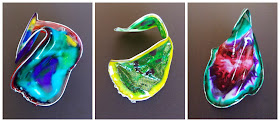 I've seen loads of melted bottle Dale Chihuly-esque art
projects for kids on Pinterest that looked amazing, but this project really
piqued my curiosity. My son and I HAD to try it.
I've seen loads of melted bottle Dale Chihuly-esque art
projects for kids on Pinterest that looked amazing, but this project really
piqued my curiosity. My son and I HAD to try it.
If you're not familiar with Dale Chihuly, the world
renowned glass artist, spend a few minutes with all the eye candy Google can
locate. His works of art are almost surreal. If you don't drop a few
"oohs" and "aws," I'll be shocked.
I showed my son some of Chihuly's work and we got started
making our own translucent sculptures.
Our Supplies
12-gauge aluminum craft wire
Klutz Window Art paint
Paintbrush
Scissors
Klutz Window Art paint
Paintbrush
Scissors
Needle nose pliers
Plastic sheet protectors
Cardboard
I cut down a few pieces of cardboard and slid it inside
the plastic sheet protectors. This was our work surface.
Then we used the scissors to cut sections of 12-gauge
wire, long enough to form an oval that would fit on the sheet protector. We
twisted the wire around each other to close the loops. I used the pliers to
tuck the ends under.
We made three loops. And then we bent them into random
amoeba-like shapes and flattened them so that the wire touched the plastic
sheet protector as much as possible.
Now came the fun part: the paint! My son and I squirted
the paint heavily along the inside edge of the wire shape. NOTE: It's important that the paint touch the wire. If it goes over,
that's fine; you can always trim the excess when dry.
Then we worked to add LOADS of paint to the interior of
the shape. We blended colors with a paint brush, making sure the paint was
thick enough to be puddling in all places.
When our shapes (his, mine, and ours) were done, we
gently moved the pieces (which is why you need a hard work surface) to a place
where they could dry for 24 hours.
And we waited.
The next day when my son came home from school, we were
brimming over with excitement. Before we got back to our art project, we
watched a video about Dale Chihuly, his studio, and the amazing works produced
there.
Then he peeled the now dried painted wire forms from the sheet protectors
and then embraced his inner sculpture, to shape the malleable piece into a
standing form.
We shaped and reshaped. It was so fun! I placed our
glass-like sculptures on the window sill where they pick up the light
beautifully.









.jpg)
















.jpg)










